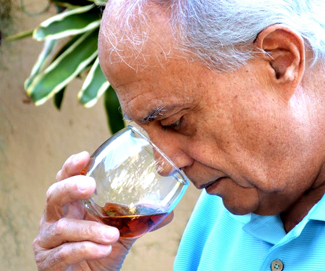Rum connoisseur interview of the week: ALFRED DAUPHIN Owner Vizcaya Wine Imports and Importer/Agent for DZAMA Rum

Rum connoisseur interview of the week:
ALFRED DAUPHIN
Owner Vizcaya Wine Imports and Importer/Agent for DZAMA Rum
1) Who is Alfred Dauphin?
Born in Port-au-Prince Haiti, the eighth generation of a family of planters and traders (salt, rum, coffee, mead, fabrics) that settled originally in the French colony of Saint-Domingue.
Educated in Mexico, Washington, D.C., and the venerable Institution St. Louis de Gonzague, Port-au-Prince.
Forced into exile in the United States in 1965 by the dictatorship of Papa Doc Duvalier, not to return on a first visit until 1997. Many friends and relatives murdered by the regime.
Proud Service – US Army 1966-68.
BA – Economics, Queens College of the City University of New York, 1971.
Became an American – 1972.
Banking career 1968 – 1987 ( P&R Teller Chemical Bank, to Vice President Corporate Lending, Barclays Bank of New York).
Owner – Brinckerhoff Liquors, & Hosner Mountain Wine Shop, Dutchess County., New York 1987-97.
Sales Representative: various distributors 1997-2006 – New York/New Jersey, Florida.
2006 to present – Owner Vizcaya Wine Imports, Inc., Wine distribution in Florida, Importer/Agent Dzama Rums of Madagascar USA. Distributor – Park Street Imports, LLC, New York, New Jersey, Florida, California.
Former wine newsletter publisher – Hudson Valley Gourmet…
2) What made you fall in love with rum and when did it happen?
When a person grows up with rum, as I practically did with Barbancourt (a top quality Haitian product made in the French tradition), he can’t really remember the specific moment or immediate cause of his love of rum. It was in the cake my mother and aunts used to make for birthdays of cousins and siblings, in the cocktail my grandfather sipped on his veranda rocking chair before his noon meal, and I still can smell it 61 years after his death.
But that love doesn’t stop at rum, it encompasses everything related to rum, everything that makes rum, and every kind of rum from the white rum that comes right out of the “alambics” (stills) located right by the sugar cane fields in the countryside of Haiti, to the sophisticated Armagnac likeness of the Barbancourt.
One of our favorite pastimes and treats my siblings, cousins, and I used to enjoy was chewing on sugar cane. There is nothing so flavorful as a fresh-cut stalk of sugar. In those days, our teeth were so strong we would strip the cane with smart bites that lifted the sharp and strong peel off of the white cellulose full of nectar. That peel is as sharp as a knife on the edges, as hard as plastic, but the reward was stupendous, full of minerals and vitamins, and excellent exercise for teeth and gums.
In its fresh juicy state, sugar is not a cause of cavities, on the contrary.
And there was molasses. Read any book on it and discover how healthful it is. Again, we ate that in liquid form with our Acassan (AK-100) a delicious morning cornmeal gruel, our Bonbons Syrop (molasses cookies). We ate in the hard version called “Rapadou” or Panela in Spanish (molasses in hard dried cake form), etc.
Rum was, in all its forms, all of its “trampes” (fresh white rum infused with all kinds of herbs, fruits, roots, flowers, et al.) some with curative powers, others aphrodisiac with quaint names like: Bois Cochon (Pig’s Baton), Zo Devant (Bone Forward), Selle-Bride (Bridled and Saddled), Liane Bande (Vine in Erection), and many other suggestive monikers.
And then there were, most importantly, the supply houses – little shops for the most part – strung along the roads, in which anybody, and I mean anybody (having bought rum there myself at the tender age of 13), could walk in and buy anything – from a shot of white rum out of a barrel for about the equivalent of an American penny, to a bottle of two-year, three-year, five-year or fifteen-year Barbancourt Reserve de la Famille. Our staple, from the age of 15 on, was the 3-year.
No license required of anyone to sell – serve – consume, no tax, no minimum age, complete freedom. Ah, those were the days!
The fresh white rum out of the barrels one could smell a block away, given the right wind direction, and we generally avoided it when we could afford better. Amazingly, most of us seldom got drunk. And that’s what usually happens when forbidden fruit is not dangled in front of your eyes out of reach. You learn to cope with it. You learn to control yourself and not shame your parents.
Rum is not rum by its lone self. It is the romance of everything that surrounds it, makes it. It even has curative powers for colds and also becomes remedy in topical applications. Its beauty begins in the field. As in this two-line poem just now inspired in “panoramic” vision.
Happy to be in the land of amber waves of grain
Having apprenticed in the greener waves of cane.
3) The biggest achievement you personally feel you have accomplished for the rum industry.
My biggest achievement, in all modesty, is to have contributed to a very small degree to the success of Rob and Robin Burr’s yearly Miami Rum Renaissance Festival. We have exhibited our unequaled Dzama Rums of Madagascar there for the last five years. It is so important that people contribute what they can to make these sorts of encounters successful in showing the diversity and sophistication of today’s rums, and take the public’s mind away from the poor notion that this is a beverage strictly acceptable in mixed drinks.
My discovery and presentation of the terroir-specific Dzama Rums at that festival (We got nine medals!) and at WSWA has been a serendipitous affair still in the process of development, a task rendered extremely difficult because of the oligopoly of a distribution system in existence in the United States. Ironically, this country goes around the world preaching free trade (B.T. – Before Trump) but allows a few companies to dominate the alcoholic beverage business in its own backyard. It even prevents free trade and free movement of alcohol between its fifty States, something Europeans, and others find very hard to get used to.
Since the introduction in Miami in 2011 of the Dzama Rums whose principal attribute is the influence of a “terroir” full of aromatic plants, and a professional approach to the production of high-quality complex white rums, there seems to have occurred a growing appreciation for the latter as sipping rums and in quality cocktails, and a tendency toward the production of an increased number of spice-infused rums.
The presence of Dzama shows that rum does not have to be infused with anything natural or artificial to be a sophisticated and multi-layered delight due mostly to the environment of the cane fields that see it born.
4) What is that thing that makes you want to continue in the rum industry?
The task of bringing the diversity of rums from Haiti is the primary concern of the moment among the rum lover circle of friends and professionals I frequent. In fact, we are interested in craft rums from all over the world, but places like Haiti and Madagascar have a special urgency in our minds.
There are around 200 distilleries in the tiny impoverished country of Haiti, each producing rum (known as Clairin, or Tafia) of individual character, each run mostly by descendants of slaves who sorely need to be organized to be able to sell their products at value-added prices, in markets capable of absorbing their production. Right now most of it is consumed locally.
It’s a herculean task, and we don’t have the money to do it. We have everything else: the product, the importation and distribution structures, and licenses. What is needed is the capital to help the distillers get their product up to US standards of reliability, those who should need it, and the facilities and equipment to store in bulk, bottle, then import in the US.
We want rum, we need rum, and Haitians need jobs. What could be a better fit? What could be more exciting than to revive an industry hundred’s of years old, to the benefit of the descendants of the slaves who cut the first cane on this continent?
In Madagascar, an employee of the Dzama distillery can actually feed a family on a salary of fewer than fifty Euros per month. Relatively small purchases here in the US mean an exponential increase in jobs over there and a lot less misery.
Those interested in finding out more, are welcome to contact me – alfreddauphin@yahoo.com.
5) Favorite Drink + Recipe
There is nothing like a simple, Haitian-style rum cocktail: simple syrup (white sugar mixed with water) to taste, one part 3-year old Barbancourt, one part lime juice, drop of bitters. I’m not against cocktails at all. Just a partisan of the fight for better flavor and quality in rum in all of its uses.
Write to me for delicious Dzama Rum Cocktails. There are some on our website below, and one can easily substitute our Dzama Cuvee Noire Classique, Prestige Cuvee Noire or Ambre de Nosy Be for lots more fun with the “Haitian” recipe. And, last but never least: our unique-on-the market 3 whites would fit into it marvelously, with two drops of bitters maybe, and a dash of Grenadine Syrup.
6) Where do you see the rum industry today and in the next 5 years?
Today the rum industry, as broached above, is still in the process of making itself understood, because it is largely new in diversity and sophistication, and new to a formerly vodka/whiskey drinking public as a quality product instead of a pirate’s knockout grog. There was a long interval in this country in rum appreciation, from colonial times to just recently. The logical sequence is the continued task of sharing the joy of a wonderful drink with those less fortunate to have only known products of “the waves of grain”.
With the increasing number of rum bars opening across the country and abroad, the next five years will see rum gain acceptance, as single malts have, even with wine lovers. A new respect is spreading across the land for sophisticated spirits appreciated for their taste, and not their hangovers. Once the function and use of a sipping rum are understood, its consumption becomes a matter of good social taste reflecting good judgment and sophistication on the user. The new era of “Shaken, not stirred” rum perhaps?
7) Share some (2-3) of your mentors and how they have helped you.
So many have been my mentors in the environment where I had the privilege to grow, It’s hard to pick a few. Let’s try a broad list: my parents, Jean Dauphin and Alice Dauphin Rigaud. My uncle Emile (Milo) Rigaud and his cultured French wife Odette Mennesson, (these two taught me the most about Haitian Clairin. They had extensive experience traveling the Haitian countryside months at a time studying the mysteries of the Voodoo religion). My friend, a former salesman from Paramount, chemist and expert oenologist – Jim Moss, who is now establishing his own vineyards in California, was a great inspiration to me. Cesar Baeza, master Chilean Oenologist is another. And of course, Franck Fohine, owner, and oenologist of the fabulous Compagnie Vidzar/Dzama Rums of Madagascar. A graduate in oenology and distillation from the University of Montpelier in the South of France. There, is a producer to behold!
We now carry six labels of Dzama. So many more in route… boggles the mind! Wait ’till people find out about the depth of product choice this company makes way down there!
Whether wine or spirit, taste is taste. People shouldn’t be surprised if I associate the two.
Rob Burr deserves special credit. His dedication is an inspiration, his knowledge without compare, and I thank him for encouraging me to go back to Haiti with him to visit some distilleries in November of ’15. One of them, the Audain facility in the Plaine du Cul-de-Sac, was a jewel to behold. Sadly, though, it is underutilized. What a shame, what a loss!
8) What 3-5 things do you have on your bucket list for the next 12 month?
3-5 things I want to do? Get Dzama really off the ground, start importing and selling Haitian Clairin, find financing to put these projects on sound footing. It would be wonderful to have some Dzama and Clairin bars around the country.
9) Any final thoughts?
9) This is way more exciting than banking! To my father, my maternal uncles Georges and Milo, my aunt Odette I owe the knowledge that Haiti’s geography is most propitious to the cultivation of sugar cane, coffee, vanilla, and other aromatic plants. One look at the Caribbean map shows a horseshoe of a land never far from the ocean breezes on the one hand, but usually in the “hurricane shadow” of the Atlantic, blessed with deep ensconced valleys and wide plains from which rise steep mountain chains (the meaning of the Arawak Indian name of Haiti) as high as eight thousand feet, that run east to west – providing plenty of sunshine year round. One result is a bevy of microclimates, from hot and desert to steamy or quite cold, that once made the country a prolific producer of the best coffee and rum in the world. Another is the existence of innumerable quantities of styles and essential environmental characters of its rums and clairins.
If I add that one of my ancestors came from Madagascar, will it then be clear why I consider myself and the story of rum inextricably bound? Few are so lucky as I feel.
10) How can people learn more about you? Website? Social Media Page?
http://www.dzamarums.com
@VizcayaWines
https://en.wikipedia.org/wiki/ Dzama
http://www.vizcayawine.com/
facebook.com/ VizcayaWineImports/













